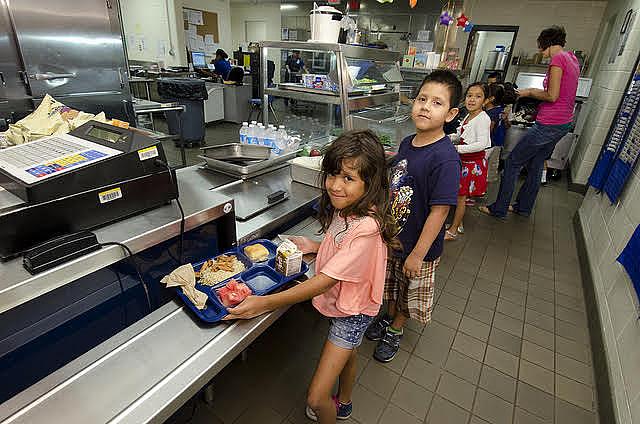Despite tempered ambitions, school lunches aren't heading back to the bad old days

School lunches have been back in the news this week after U.S. Agriculture Secretary Sonny Perdue announced that his first big move would be to relax school nutrition standards that Michelle Obama made one of her signature policy initiatives.
But the announcement’s political bark — Trump guts another piece of the Obama legacy — turned out to be bigger than its bite, as reporters quickly made clear. “Overall, Trump admin really didn't go far in relaxing @MichelleObama school meal standards,” tweeted Politico’s Helena Bottemiller Evich. “Tweaked, not trashed.”
Those tweaks? School districts can now apply for a waiver that will allow them to serve foods that aren’t “whole-grain rich” (earlier legislation had already granted such flexibility). Current sodium limits remain in place — 1,230 milligrams for elementary student lunches — but the more stringent sodium reductions planned for the coming years will be delayed. Kids can now have chocolate milk with 1 percent fat content, a level formerly only allowed for white milk.
These are not head-spinning policy shifts. Bettina Elias Siegel, who tracks these trends on her blog The Lunch Tray, helpfully placed the changes in perspective this week:
The upshot? The Perdue announcement does move school meals in the wrong direction, but most of the very significant gains made by the Healthy, Hunger-Free Kids Act remain intact. We still have common sense calorie limits for school meals, for example, as well as a ban on trans fats and a requirement that kids get a greater variety of vegetables each week. And despite years of lobbying by the School Nutrition Association, Perdue made no change to one of the most important advances of the HHFKA — a requirement that kids must take a half-cup serving of fruits or vegetables at lunch, instead of passing up those healthy foods on a daily basis.
Meanwhile, reporters were treated to some Onion-worthy quotes. “Try eating a biscuit made with whole grains," said Senate Agriculture Chairman Pat Roberts (R-Kan.). “It just doesn't work!” Perdue, accompanied by Roberts in a Virginia elementary school cafeteria for the announcement, was not to be outdone: “I wouldn’t be as big as I am today without chocolate milk.”
While it’s hard to fact check that last claim, we do have some evidence to evaluate another assertion from Perdue, namely that healthier school lunches are getting trashed. “We all know that meals can’t be nutritious if they aren’t consumed, if they’re put in the trash,” he said in his announcement.
Last year, researchers at the Center for Public Health Nutrition at the University of Washington in Seattle published a study in JAMA Pediatrics that looked at how tougher nutrition standards under the Healthy Hunger-Free Kids Act have changed how many kids are eating at school.
The study, which focused on an urban school district with three middle schools and three high schools in Washington state, had the distinct advantage of being able to collect data on what kids were eating for 16 months before the stricter nutrition rules went into effect and 15 months afterwards. That before-and-after study design meant that researchers would be able to tell if meals suddenly started piling up in trashcans.
That’s not what the study found:
“There was negligible difference in student meal participation following implementation of the new meal standards with 47 percent meal participation prior to the implemented policy and 46 percent participation afterward,” the researchers wrote.
In short, there was no student revolt. And researchers found the new nutrition standards were “associated with significant improvement in the nutritional quality of foods chosen by students.”
Of course, Washington state is not Georgia, and school cafeterias in the Northwest are unlikely to serve kids grits (black flakes in whole-grain grits were a problem in the South, according to Perdue). And this is just one study. Another study of two schools in the Northeast found kids’ consumption of veggies and fruits dipped 13 percent after the new rules, while waste went from a quarter-cup per tray to 39 percent of a cup per student. Yet another study from researchers the Harvard School of Public Health found that fruit consumption was unchanged but vegetable consumption went up 16 percent after the new rules took effect.
While the research findings may be a mixed bag, it’s always worth asking what the evidence base is for such policy moves. The School Nutrition Association, which represents cafeteria workers, has loudly and consistently criticized the tougher nutrition targets ushered in by the Healthy Hunger-Free Kids Act, claiming they’ve led to skipped meals, heaping trash cans, added costs and frustrated school cooks. But it’s also worth noting the group receives half of its funding from the food industry, as Politico reported, and many of those companies’ profits depend on peddling less nutritious fare.
That doesn’t mean the problems the group outlines should be ignored — ask any parent about the challenges of pushing whole grains and veggies — but it does mean reporters should keep a healthy sense of skepticism and sharp eyes on the evidence, when it comes to claims of lunch-line misery.
**

